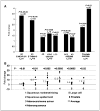RGS17, an overexpressed gene in human lung and prostate cancer, induces tumor cell proliferation through the cyclic AMP-PKA-CREB pathway
- PMID: 19244110
- PMCID: PMC2746047
- DOI: 10.1158/0008-5472.CAN-08-3495
RGS17, an overexpressed gene in human lung and prostate cancer, induces tumor cell proliferation through the cyclic AMP-PKA-CREB pathway
Abstract
We have identified RGS17 as a commonly induced gene in lung and prostate tumors. Through microarray and gene expression analysis, we show that expression of RGS17 is up-regulated in 80% of lung tumors, and also up-regulated in prostate tumors. Through knockdown and overexpression of RGS17 in tumor cells, we show that RGS17 confers a proliferative phenotype and is required for the maintenance of the proliferative potential of tumor cells. We show through exon microarray, transcript analysis, and functional assays that RGS17 promotes cyclic AMP (cAMP)-responsive element binding protein (CREB)-responsive gene expression, increases cAMP levels, and enhances forskolin-mediated cAMP production. Furthermore, inhibition of cAMP-dependent kinase prevents tumor cell proliferation, and proliferation is partially rescued by RGS17 overexpression. In the present study, we show a role for RGS17 in the maintenance of tumor cell proliferation through induction of cAMP signaling and CREB phosphorylation. The prevalence of the induction of RGS17 in tumor tissues of various types further implicates its importance in the maintenance of tumor growth.
Conflict of interest statement
No potential conflicts of interest were disclosed.
Figures





Similar articles
-
PKA and cAMP stimulate proliferation of mouse embryonic stem cells by elevating GLUT1 expression mediated by the NF-κB and CREB/CBP signaling pathways.Biochim Biophys Acta. 2012 Oct;1820(10):1636-46. doi: 10.1016/j.bbagen.2012.05.008. Epub 2012 May 29. Biochim Biophys Acta. 2012. PMID: 22658979
-
The cAMP signalling pathway activates CREB through PKA, p38 and MSK1 in NIH 3T3 cells.Cell Signal. 2005 Nov;17(11):1343-51. doi: 10.1016/j.cellsig.2005.02.003. Epub 2005 Mar 16. Cell Signal. 2005. PMID: 16125054
-
The role of cyclic AMP response element binding protein in transactivation of scavenger receptor class B type I promoter in transfected cells and in primary cultures of rat theca-interstitial cells.Mol Cell Endocrinol. 2005 Dec 21;245(1-2):23-30. doi: 10.1016/j.mce.2005.09.013. Epub 2005 Nov 18. Mol Cell Endocrinol. 2005. PMID: 16298471
-
Regulator of G Protein Signaling 17 as a Negative Modulator of GPCR Signaling in Multiple Human Cancers.AAPS J. 2016 May;18(3):550-9. doi: 10.1208/s12248-016-9894-1. Epub 2016 Feb 29. AAPS J. 2016. PMID: 26928451 Free PMC article. Review.
-
Role of the PKA-regulated transcription factor CREB in development and tumorigenesis of endocrine tissues.Ann N Y Acad Sci. 2002 Jun;968:65-74. doi: 10.1111/j.1749-6632.2002.tb04327.x. Ann N Y Acad Sci. 2002. PMID: 12119268 Review.
Cited by
-
CREB1 directly activates the transcription of ribonucleotide reductase small subunit M2 and promotes the aggressiveness of human colorectal cancer.Oncotarget. 2016 Nov 22;7(47):78055-78068. doi: 10.18632/oncotarget.12938. Oncotarget. 2016. PMID: 27801665 Free PMC article.
-
Phosphorylation of RGS13 by the cyclic AMP-dependent protein kinase inhibits RGS13 degradation.J Mol Cell Biol. 2010 Dec;2(6):357-65. doi: 10.1093/jmcb/mjq031. Epub 2010 Oct 25. J Mol Cell Biol. 2010. PMID: 20974683 Free PMC article.
-
High-resolution structure of RGS17 suggests a role for Ca2+ in promoting the GTPase-activating protein activity by RZ subfamily members.J Biol Chem. 2019 May 17;294(20):8148-8160. doi: 10.1074/jbc.RA118.006059. Epub 2019 Apr 2. J Biol Chem. 2019. PMID: 30940727 Free PMC article.
-
Decreased RGS6 expression is associated with poor prognosis in pancreatic cancer patients.Int J Clin Exp Pathol. 2014 Jun 15;7(7):4120-7. eCollection 2014. Int J Clin Exp Pathol. 2014. PMID: 25120791 Free PMC article.
-
Fragment-Based Nuclear Magnetic Resonance Screen against a Regulator of G Protein Signaling Identifies a Binding "Hot Spot".Chembiochem. 2021 May 4;22(9):1609-1620. doi: 10.1002/cbic.202000740. Epub 2021 Feb 16. Chembiochem. 2021. PMID: 33480159 Free PMC article.
References
-
- Rangel J, Nosrati M, Leong SP, et al. Novel role for RGS1 in melanoma progression. Am J Surg Pathol. 2008;32:1207–12. - PubMed
-
- Gu J, Wu X, Dong Q, et al. A nonsynonymous single-nucleotide polymorphism in the PDZ-Rho guanine nucleotide exchange factor (Ser1416Gly) modulates the risk of lung cancer in Mexican Americans. Cancer. 2006;106:2716–24. - PubMed
-
- Berman DM, Wang Y, Liu Z, et al. A functional polymorphism in RGS6 modulates the risk of bladder cancer. Cancer Res. 2004;64:6820–6. - PubMed
-
- Mao H, Zhao Q, Daigle M, Ghahremani MH, Chidiac P, Albert PR. RGS17/RGSZ2, a novel regulator of Gi/o, Gz, and Gq signaling. J Biol Chem. 2004;279:26314–22. - PubMed
-
- Berman DM, Gilman AG. Mammalian RGS proteins: barbarians at the gate. J Biol Chem. 1998;273:1269–72. - PubMed
Publication types
MeSH terms
Substances
Grants and funding
LinkOut - more resources
Full Text Sources
Other Literature Sources
Medical
Molecular Biology Databases

